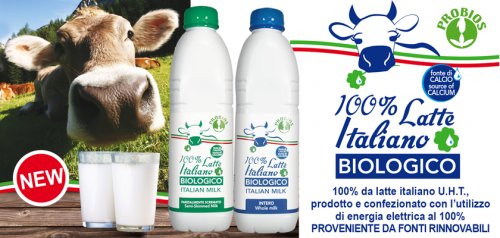
This is the conclusion of a study comparing traditional non-organic whole milk and organic milk with regard to the fatty acid content, just published in PLoS One:
www.plosone.org (original article in English in pdf download HERE.
https://www.dropbox.com/s/zfha4o2ysz4d3pk/Organic%20Production%20Enhances%20Milk%20Nutritional%20Quality%202013.pdf )
The authors, researchers at Washington State University's Center for Sustaining Agriculture and Natural Resources (CSANR), have thus analyzed 384 samples of whole milk both organic and conventional, over 18 months, and have found that, for the same total fatty acids , compared to normal milk, the first contains more omega-3 (+ 65%), considered friends of the heart and present, for example, in fish, and less omega-6 (-25%), contained in the chips and in other unhealthy food. These differences mean that the relationship between the two, considered the fundamental parameter, is 2.28, a value that is much closer to the one considered ideal (2,3) compared to that of conventional milk (equal to 5.77) .
According to many studies, the typical Western diet has a ratio between 10 and 15 to 1 when the ideal value should be greater than 2.3 to 1. The major fatty acid content of omega-3 of organic milk is due to the fact that the cows must graze outdoors eating untreated grass and fodder, while the animals intended to produce milk for industrial processes usually live most of their lives indoors, feeding on feed mixtures prepared according to specifications, which fail to provide such a high content in omega-3.
To understand the potential of organic milk, the authors have made a major confrontation with fish. The conclusions are clear, those who drink daily recommended amount of organic milk (three cups) assumes a quantity of omega-3 greater than the one present in the ration of fish expected in nutritional tables. At the same weight, the milk has a normal amount of omega-3 fatty acids that is nine times higher than the one of fish, and the organic milk arrives in a ratio of 14 to 1.
The authors have tried to assume a change in the diet of a western woman. Given that normally we assume foods capable of giving a ratio among fatty acids of omega-6 and omega-3 equal to 11.3, the problem is how to reduce the value to 2.3. Research shows that 40% of this decline of five points could be achieved by increasing the number of daily servings of milk or dairy products (provided that all full-fat and organic) from the three recommended to the population average to 4.5. Even just giving up every day to some food rich in omega-6, the same women could obtain a value of 4.80 close enough to the ideal.
The study was funded by the Organic Valley, the largest cooperative of American producers of organic milk, who asked the researchers to conduct an independent investigation on the composition of organic milk and traditional products in the same areas.
Note - For the purposes of reg. CE n.1924 / 2006, the results of the study can not be used as a basis for claim in the labeling, advertising and presentation to the public.





